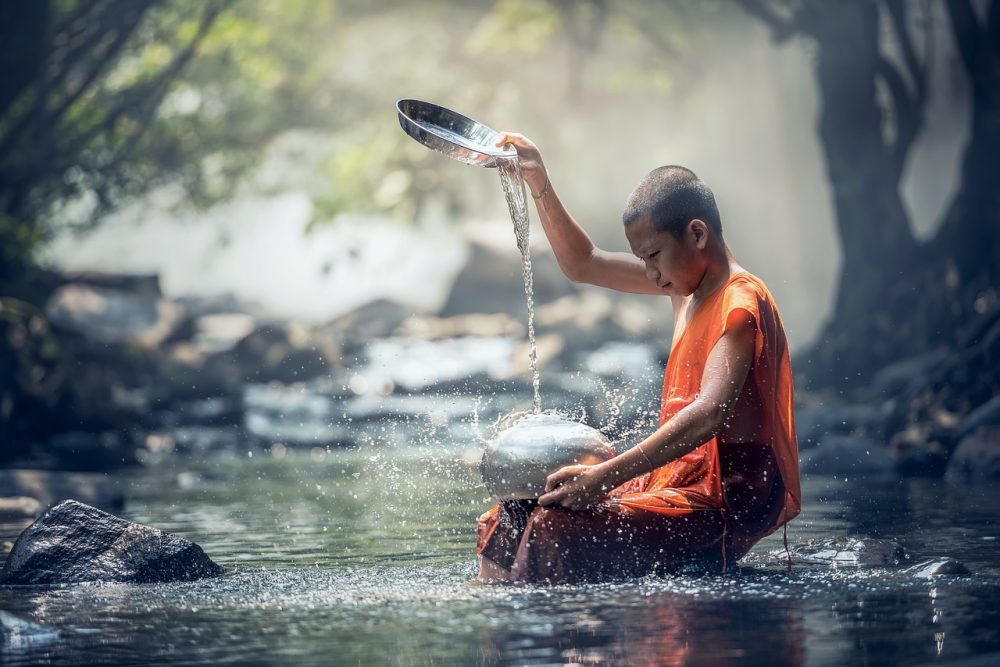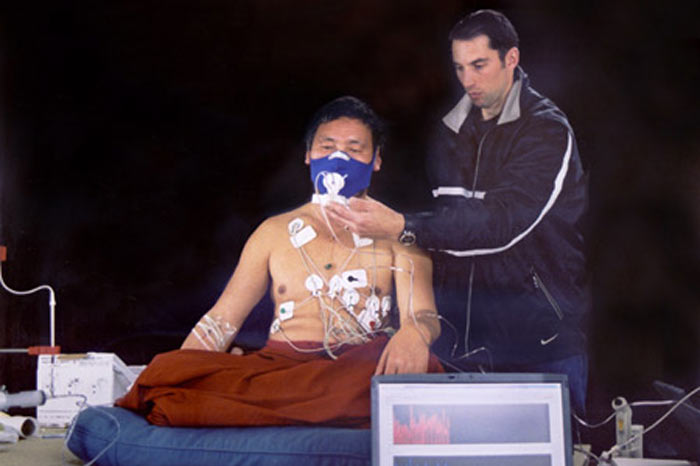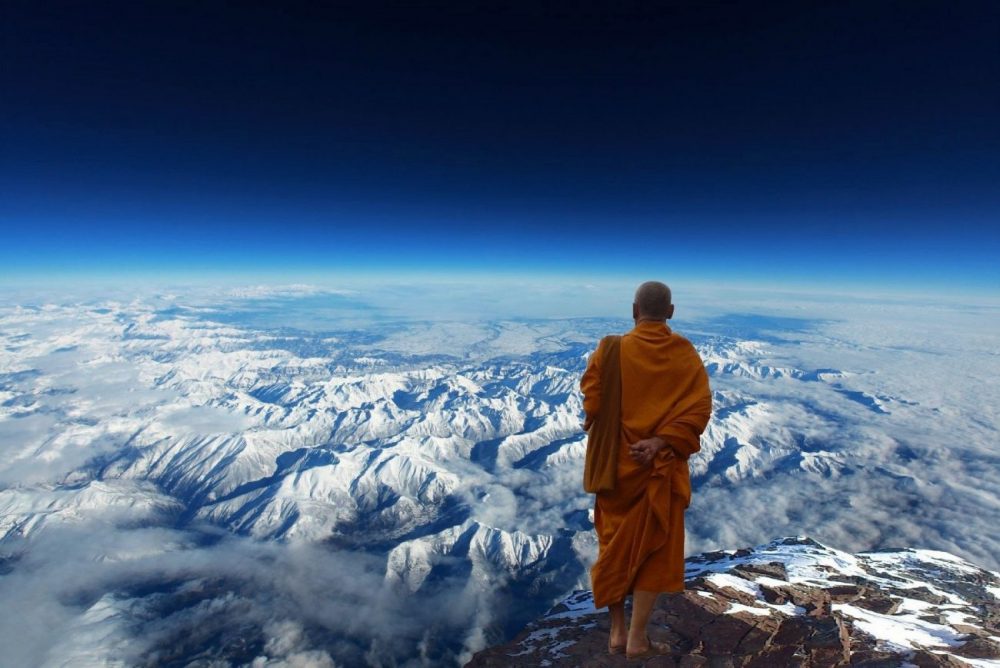Harvard study suggests Tibetan Monks are able to control and raise body temperature using their mind.
Have you ever wondered how powerful meditation really is? Harvard experts have studied Himalayan Monks for decades. They were the few lucky ones who were allowed inside the secretive world of distant and isolated monasteries, where Monks, who have studied ancient teachings their entire life, have obtained what is perhaps best described as ‘supernatural abilities.’
Quick Facts
- “g-Tummo” meditation allows monks to raise their fingers and toes’ temperatures by as much as 17 degrees Fahrenheit.
- Monks performing “g-Tummo” meditation can dry, using their body only, sheets soaked in freezing water. Experts witnessed how steam would emerge after the Monks would increase their body temperatures to dry the sheets.
- Scientists still do not understand how this heat is generated.
- Deep Meditation States allow monks to lower their metabolism by 64 percent.
- In Freezing temperatures, at around -18 Degrees Celsius, Monks in deep meditation states can survive throughout the entire night, wearing only cotton shawls.
- Many religious centers located deep within the Himalayas keep these ‘powerful’ meditative procedures a closely guarded secret.

Scientists wanted to understand how powerful and useful meditation really was and whether or not tales of Monks performing supernatural feats were the result of legend and myths or an unknown reality to western societies.
In the 1980s, some of the very first studies took place
In 1982, Harvard Medical School researcher Herbert Benson traveled to India to study and investigate Tibetan practitioners of “g-Tummo” Meditation.
To the surprise of Benson and his team, the Monks demonstrated they could raise and control the temperature of different parts of their body, using only their mind.
Scientists were left stumped; the Mind really controls the body in extreme experiments.
The scientists witnessed the monks perform a technique called g-Tummo meditation, where monks would enter a state of deep meditation.
The g-tummo meditative practice targeted at controlling “inner energy” is described by Tibetan practitioners as one of the most sacred spiritual practices in the Indo-Tibetan traditions of Vajrayana Buddhism and Bon. It is also called “psychic heat” practice since it is associated with descriptions of intense sensations of bodily heat in the spine. Little is known about the specifics of the g-tummo technique. Monasteries maintaining an extensive practice of g-tummo are quite rare and located mostly in the remote Chinese provinces of Qinghai and Sichuan (also known as eastern Tibet). Eyewitness accounts describe g-tummo practitioners as being able to generate sufficient heat to dry wet sheets wrapped around their naked bodies, producing a visible amount of steam, while sitting or walking in the freezing cold of the Himalayas. — Neurocognitive and Somatic Components of Temperature Increases during g-Tummo Meditation: Legend and Reality

An example of the amazing achimenes of Tibetan monks was witnessed when experts visited a monastery in Northern India.
There, a group of Tibetan monks sat peacefully and quietly in a room.
The temperature inside the room was chilly, at around 40 degrees Fahrenheit.
Other monks would then approach their mediating colleagues and cover them in soaked 3-by-6-foot sheets in cold water (49 degrees) and placed them over the meditators’ shoulders.
Ordinary people would produce uncontrolled shivering as their bodies react to the cold. In fact, scientists say that if a person’s body temperature would continue to drop under these ‘extreme conditions,’ death can result.
But to the surprise of scientists observing the monks in deep meditation, soon after the water-soaked sheets were placed on their shoulder, steam began appearing from the sheets.
Scientists were left stunned: the body heat produced by the monks during their meditations was causing the sheets to dry. Around an hour later, the water-soaked sheets were completely dry.
This experiment was repeated as scientists observed the monks as the meditators were covered with another chilled, wet set of sheets.

“Buddhists feel the reality we live in is not the ultimate one. There’s another reality we can tap into that’s unaffected by our emotions, by our everyday world. Buddhists believe this state of mind can be achieved by doing good for others and by meditation. The heat they generate during the process is just a by-product of g Tum-mo meditation.” — professor Herbert Benson.
During s visit to several religious sites in the 1980s, Professor Benson and his team studied monks living in the Himalayan Mountains who could, by using g Tum-mo meditation, raise the temperatures of their fingers and toes by as much as 17 degrees.
This has left experts stumped, as it has yet to be determined how the monks can generate such heat.
But the scientists performed further studies as they traveled to Sikkim, in northeastern India, where they measured and studied forms of advanced meditation. Experts were again left sumped by the fact that the Monks had the ability to lower their metabolism by an astonishing sixty-four percent.
This is beyond extraordinary, scientists revealed. In ordinary humans, metabolism, or oxygen consumption, has been found to drop by only 10-15 percent in sleep and about 17 percent during simple meditation forms.

Compared to the sixty-four percent achieved by monks, it’s something out of the ordinary. It can easily be said that these monks possess superhuman abilities compared to ordinary humans.
Furthermore, in 1985, researchers witnessed monks spending a winter night atop a rocky ledge 15,000 feet high in the Himalayas. The temperatures at night dropped below 0 degrees Fahrenheit (around -18 Degrees Celsius).
Dressed with only woolen shawls, the monks eventually fell asleep on the ledge. Scientists observed them. None of the monks huddled together. They did not shiver and managed to sleep through the night without problems. In the morning, as they woke up, they walked back to their monasteries, feeling refreshed and full of energy.
The result of Benson’s study was described and published in Nature in 1982:
Since meditative practices are associated with changes that are consistent with decreased activity of the sympathetic nervous system, it is conceivable that measurable body temperature changes accompany advanced meditative states. With the help of H.H. the Dalai Lama, we have investigated such a possibility on three practitioners of the advanced Tibetan Buddhist meditational practice known as g Tum-mo (heat) yoga living in Upper Dharamsala, India. We report here that in a study performed there in February 1981, we found that these subjects exhibited the capacity to increase the temperature of their fingers and toes by as much as 8.3 degrees Celsius.
Join the discussion and participate in awesome giveaways in our mobile Telegram group. Join Curiosmos on Telegram Today. t.me/Curiosmos

